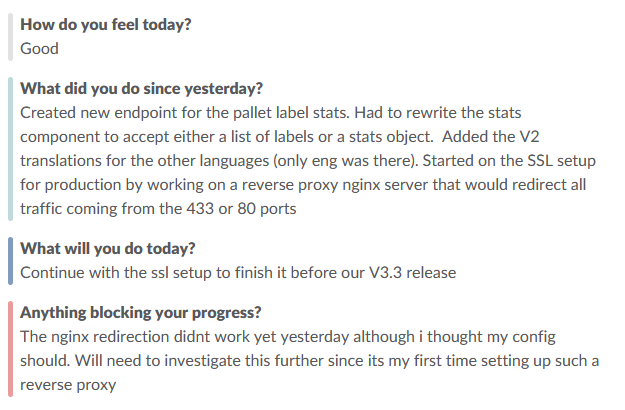⚡ Asana & Agile Guidelines
This page goes over how agile is used inside the Flowcontrol dev team. It also explains how Asana is used to manage the project progression, tasks, etc.
🚀 Our way of working agile
Our way of working is a form of Agile. Due to our small dev team we created our own way of working that fits our needs.
At the start of the working day each dev fills in their daily stand-up on Slack. These stand-ups are quite self-explanatory, but they’re a way to keep the team informed about what you’re working on, what you’ve done, and what you’re planning to do.
📋 Questions
How do you feel today? — state if everything is okay or if you’re having a bad day.
What did you do since yesterday? - explain the steps you’ve taken since yesterday. Geek bot will state: this is what you did yesterday, but you HAVE to add more information than just; the same, continue doing it.
What will you do today? — explain the steps you hope to achieve today. Be explicit and not generic like; the same as yesterday, fixing a bug, picking up a new ticket.
Anything blocking your progress? - state if you’re blocked by something. This can be a technical issue, a question, or anything else.
❌ An example of a bad standup:

✅ An example of a good standup:

Every 2 weeks we have a sprint planning. This is a meeting where we discuss what we’re going to do in the next 2 weeks. We create a list of tasks that need to be done and assign them to the devs. This meeting happens together with our PO (Rob).
During this sprint planning we first take some time to look back at the last 2 weeks, what we achieved, learned, didn't go well and want to improve. This is called the retrospective.
📔 Asana
Asana is used as our project management tool. We use it to keep track of our tasks, bugs, and features. Asana is divided into six sections:
- In-progress: This is where all the tasks that are currently being worked on are stored. These tasks are assigned to a dev.
- Short term to-do: This is where all the tasks that need to be done in the next 2 weeks are stored. These tasks aren’t assigned to anyone yet. They are however, already defined and accompanied of a description detailing the task.
- Backlog: This is where all the tasks are stored. These tasks aren’t assigned to anyone yet. They are however, already defined and accompanied of a description detailing the task.
- Requests: This is where all the tasks that are requested by anyone are stored. They often need a proper description or an investigation if we’re interested in doing them.
- To validate: This is where some of the tasks that are done are stored. These specific tasks are considered done, but need some validation, either from another dev, user or the PO.
- Done: This is where all the tasks that are done are stored. These tasks are considered done and are closed.
When creating a new item, you have to decide how likely it is that we will pick it up. Is it a random new feature? Put it on the request list. If it's a bug, put it on the backlog. Ask yourself; what value does it bring?
📝 Note
When writing items on the backlog, ensure they have:
- An intuitive title
- A clear description
- Images / GIF / links that show issues/examples (if applicable)
- What needs to be done to complete the task